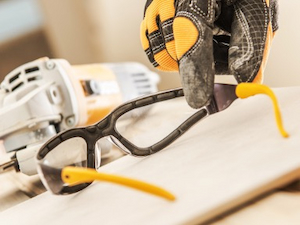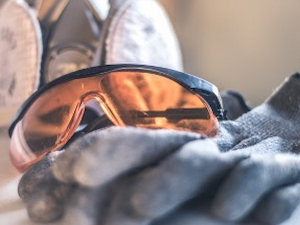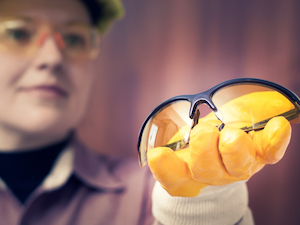Eye injuries can happen in the blink of an eye, and they’re almost always preventable.

On job sites across every industry, workers are exposed to hazards that put their eyesight at risk. Flying particles, metal fragments, or sparks can all cause permanent eye damage in a matter of seconds. That’s why OSHA requires workers to wear safety glasses whenever there’s a risk of flying debris, dust, impact hazards, or light radiation.
Job Hazards That Cause Eye Injuries
Workers often believe short or “low-risk” tasks don’t need eye protection. But it only takes a drill bit breaking, a grinder throwing off shavings, or a nail recoiling to cause a serious eye injury. Safety glasses are designed to stop these hazards before they reach your eyes.
Safety glasses are your last line of defense when something goes wrong on the job. They can help protect against:
- Flying particles from cutting, drilling, grinding, and sawing
- Dust, dirt, and other airborne debris
- Sparks and fragments from grinding or cutting
- Impact from hand tools and power tools during use
- Materials that slip, strike, or shatter
- Nails, fasteners, or wire ends that snap under tension
- Chips and splinters created by hammering or chiseling
Choosing the Right Safety Glasses
Not all safety glasses are made the same. OSHA requires that protective eyewear meet the ANSI Z87.1 standard. When choosing your safety glasses, look for the Z87 mark on the frame or lens.
From basic impact-resistant lenses to prescription safety glasses, workers should know which type best matches the job at hand.
OSHA Standard 1926.95(c) and 1910.132(c) Employers must ensure that all personal protective equipment is of safe design and construction for the work to be performed and is selected to ensure that it fits each affected employee.
Safety glasses with impact-resistant ANSI Z87.1 lenses are the most common type used in workplaces. They are designed to protect against everyday impact hazards like flying particles and small debris.

Prescription safety glasses combine vision correction with certified ANSI Z87.1 protection, allowing workers who need corrective lenses to see clearly without sacrificing safety.
Safety glasses with side shields offer additional coverage, blocking hazards that might approach from the sides. The side shields on safety glasses may be permanent or detachable depending on the level of protection needed.
Over-the-glasses (OTG) safety glasses are built to fit comfortably over regular prescription eyewear while still meeting ANSI Z87.1 standards, ensuring workers with glasses are protected.
Infrared (IR) safety glasses provide limited protection from infrared light. For tasks with higher radiant heat exposure, additional protection such as face shields or helmets may be necessary.
Welding safety glasses feature shaded lenses for light welding tasks or torch work. They are also commonly used as secondary protection under a welding helmet, but not as a replacement.

Some safety glasses have specialized lenses or coatings that enhance protection and performance. Safety glasses with tinted lenses reduce brightness from outdoor sunlight. Polarized lenses reduce glare from reflective surfaces such as water, glass, or metal, improving visibility and reducing eye strain in bright environments. UV-protection blocks harmful ultraviolet rays that can damage the eyes with prolonged exposure to sunlight. Anti-fog coatings on glasses prevent lenses from fogging in humid conditions and anti-scratch coatings extend the life of the lenses.
Wearing and Maintaining Safety Glasses
Even the best safety glasses won’t work if they aren’t worn correctly. Poor fit is one of the top reasons workers avoid using their PPE.
Safety glasses that are too tight cause discomfort, while loose glasses may slip or leave dangerous gaps. Make sure safety glasses fit snugly without slipping and report fit issues so they can be adjusted or replaced.
OSHA Standard 1926.95(b) and 1910.132(b) Where employees provide their own protective equipment, the employer shall be responsible to assure its adequacy, including proper maintenance, and sanitation of such equipment.

Just as important as fit is proper maintenance. Safety glasses that are scratched, cracked, or dirty not only reduce visibility but also weaken their ability to protect against impact.
Workers should inspect lenses daily for cracks or scratches and clean them with approved wipes or solutions, never paper towels that can cause smudges and scratches.
OSHA Standard 1926.95(a) and 1910.132(a) Personal protective equipment for eyes shall be provided, used, and maintained in a sanitary and reliable condition.
Proper Storage of Safety Glasses
Safety glasses should never be left on vehicle dashboards, work surfaces, or carried in back pockets, where they can easily be scratched, bent, or broken. Heat from a dashboard can warp frames and damage lens coatings, while leaving glasses on a cluttered bench or tossing them loosely in a toolbox increases the chance that they’ll get dirty or cracked. Carrying them in a back pocket almost guarantees they’ll be sat on and ruined. To keep safety glasses reliable, they should always be stored in a protective case, pouch, or designated rack.

When Safety Glasses Aren’t Enough
While safety glasses are critical, they aren’t designed for every hazard. Goggles are required for work involving chemical splashes or corrosive liquids. And for tasks like grinding, cutting, or welding where sparks, heat, or larger debris are present, a face shield must be worn in addition to safety glasses. In welding, a properly rated helmet may also be required.
Eye injuries are painful, costly, and often permanent. Safety glasses are one of the easiest and most affordable ways to prevent them. Treat them as essential equipment, not an afterthought.
By wearing safety glasses every time a hazard is present, and taking care of them properly, workers can protect their vision for life.

.jpeg)
.jpeg)
